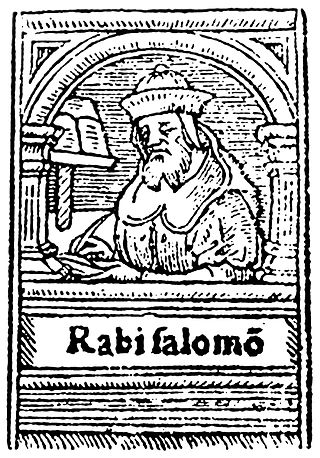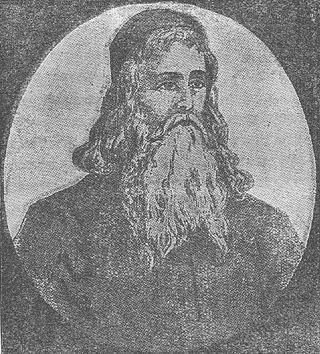Related Research Articles

Shlomo Yitzchaki, generally known by the acronym Rashi, was a medieval French rabbi, the author of comprehensive commentaries on the Talmud and Hebrew Bible.
Asher ben Jehiel was an eminent rabbi and Talmudist best known for his abstract of Talmudic law. He is often referred to as Rabbenu Asher, “our Rabbi Asher” or by the Hebrew acronym for this title, the Rosh. His yahrzeit is on 9 Cheshvan.

The Tosafot,Tosafos or Tosfot are medieval commentaries on the Talmud. They take the form of critical and explanatory glosses, printed, in almost all Talmud editions, on the outer margin and opposite Rashi's notes.
Rishonim were the leading rabbis and poskim who lived approximately during the 11th to 15th centuries, in the era before the writing of the Shulchan Aruch and following the Geonim. Rabbinic scholars subsequent to the Shulchan Aruch are generally known as acharonim.
Chananel ben Chushiel or Ḥananel ben Ḥushiel, an 11th-century Kairouanan rabbi and Talmudist, was in close contact with the last Geonim. He is best known for his commentary on the Talmud. Chananel is often referred to as Rabbeinu Chananel – Hebrew for "our teacher, Chananel".

Shmuel Eidels was a renowned rabbi and Talmudist famous for his commentary on the Talmud, Chiddushei Halachot. Eidels is also known as Maharsha.
Samuel ben Meir, after his death known as the "Rashbam", a Hebrew acronym for RAbbi SHmuel Ben Meir, was a leading French Tosafist and grandson of Shlomo Yitzhaki, "Rashi".
Rabbi Moses ben Jacob of Coucy, also known as Moses Mikkotsi, was a French Tosafist and authority on Halakha. He is best known as the author of one of the earliest codifications of Halakha, the Sefer Mitzvot Gadol.
Tobiah ben Eliezer was a Talmudist and poet of the 11th century, author of Lekach Tov or Pesikta Zutarta, a midrashic commentary on the Pentateuch and the Five Megillot.
Samson ben Abraham of Sens ,was one of the leading French Tosafists in the second half of the 12th and the beginning of the 13th centuries. He was the most outstanding student and the spiritual heir of Rabbi Isaac ben Samuel ha-Zaken. He is referred also known as "the Rash" or "the Prince of Sens", and within Tosafot as "Rashba".
Isaac ben Meir, also known as the Rivam after his Hebrew acronym, was a French rabbi and one of the Baalei Tosafos.
Isaac ben Samuel the Elder, also known as the Ri ha-Zaken, was a French tosafist and Biblical commentator. He flourished at Ramerupt and Dampierre, France in the twelfth century. He is the father of Elhanan ben Isaac of Dampierre.
Judah ben Isaac Messer Leon (1166–1224) was a French tosafist born in Paris.
Rashi's daughters were the three daughters and only children of the medieval Talmudic scholar, Rashi and his wife Rivka. Their three daughters were Yocheved, Miriam and Rachel. They each married their father's finest students and were the mothers of the leaders of the next generation of French Talmudic scholars. Almost every Ashkenazi rabbinic dynasty traces its ancestry back to either Yocheved or Miriam, and the majority of the tosafists, were recent descendants of Rashi's daughters. All born in Troyes, France, their descendants inhabited Germany, France, and Italy in the early 11th to 15th centuries, with the majority later moving to Eastern Europe, where they established several notable rabbinic dynasties.
Machir ben Judah was a French Jewish scholar of the tenth and eleventh centuries, born at Metz, and brother of R. Gershom "the Light of the Exile".
Meir ben Samuel, also known by the Hebrew acronym RaM for Rabbi Meir, was a French rabbi and tosafist, who was born in about 1060 in Ramerupt, and died after 1135. His father was an eminent scholar. Meir received his education in the Talmudical schools of Lorraine, his principal teachers being Isaac ben Asher ha-Levi and Eleazar ben Isaac of Mainz, with whom he later carried on a correspondence.

Isaac ben Melchizedek, was a rabbinic scholar from Siponto, Italy, and one of the first medieval scholars to have composed a commentary on the Mishnah, of which only his commentary on Seder Zera'im survives. Elements of the Mishnaic order of Taharot are also cited in his name by the Tosafists, but the complete work is no longer extant.
Rabbi Samson ben Yosef the Elder of Falaise was one of the Tosafot. His brother-in-law was Rabbeinu Tam, who held him in high esteem.
Rabbi Solomon ben Meir was Rashi's grandson. He was born after Rashi's death and is therefore named for his grandfather. He was one of the Tosafot.
References
- ↑ Makkot 19b: "Our master's body was pure, and his soul departed in purity, and he did not explain any more; from here on is the language of his student Rabbi Yehudah ben Nathan."
- ↑ Eliezer b. Joel ha-Levi, Abi ha-'Ezri, §§ 183, 385, 397, 408
- ↑ Semag, prohibition No. 79
- ↑ Gross, Henri (1897). Gallia Judaica - Dictionnaire Geographique de la France d'Apres les Sources Rabbiniques. Philo Press. pp. 509-512.
![]() This article incorporates text from a publication now in the public domain : Joseph Jacobs and M. Seligsohn (1901–1906). "Tosafot". In Singer, Isidore; et al. (eds.). The Jewish Encyclopedia . New York: Funk & Wagnalls.
This article incorporates text from a publication now in the public domain : Joseph Jacobs and M. Seligsohn (1901–1906). "Tosafot". In Singer, Isidore; et al. (eds.). The Jewish Encyclopedia . New York: Funk & Wagnalls.